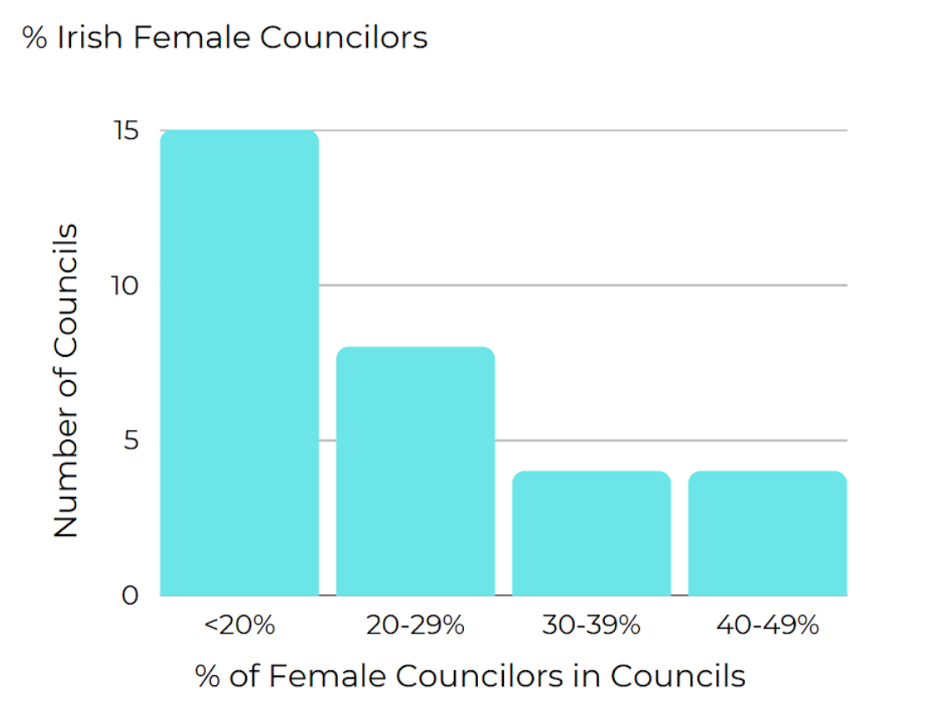Does Gender Affect Political Careers? A Glimpse at Local Irish Councils
Alisha Saxena (she/her) is a second-year Master of Public Policy (MPP ’23) student at Georgetown University. The following research was conducted during her time as a 2021-22 Global Irish Studies Fellow, and she is currently furthering this project as a 2022-23 Fellow.
Across 31 local councils in the Republic of Ireland, women only occupy about 25% of all council seats (Saxena 2023). Organizations like the National Women’s Council of Ireland (NWCI) commonly note that this underrepresentation largely exists due to a shortage of female candidates (Hunt 2022). As a result, these organizations focus on getting more women to run for office so that, hopefully, more women will win seats in governing bodies. While this goal is shared by women’s political organizations worldwide, it is important to determine the extent to which gender inequality affects council membership, leadership, and operations. First, this project explored whether there is an association between lower levels of female representation and lower levels of female leadership in local councils. Second, this project explored whether higher degrees of voter support on women’s issues translated to higher women’s representation in local councils.

This project hand-collected statistics on Irish local councils through council websites and meeting minutes. Analysis revealed that Irish local councils are greatly varied in their progress towards gender parity, ranging from 5% to 46% female representation. Council leadership changes every year, but the project focused on 2021-2022 and found that only 9 of 31 councils (~29%) appointed a female mayor or Cathaoirleach (Saxena 2023).
Beyond looking at the highest council leadership, this project also looked at the gender breakdowns of membership and leadership for these councils’ Strategic Planning Committees (SPCs). These committees were not uniform across all councils, so they were broadly grouped under six categories: economic development, environment, arts and culture, transportation and infrastructure, housing, and urban planning (Saxena 2023).
Across all six categories, there were more male leaders than female leaders. This project correctly hypothesized that women leaders would represent arts and culture SPCs the most, but incorrectly hypothesized that women would be least likely to represent economic development SPCs. In reality, women were least likely to lead transportation and infrastructure SPCs. Although this report hypothesized that women in male-dominant councils were less likely to chair economic SPCs, this was clearly rejected by the data (Saxena 2023).
A look at SPC membership, however, produced mixed results. The data partially supported the hypothesis that councils with lower female representation would have fewer women in the economic SPCs. Though all 4 councils with no female representation on economic SPCs fell in the lowest tier of women’s representation (20% or lower), many councils in this tier still managed to achieve proportional representation of women on these SPCs. Looking at arts and culture, this hypothesis was entirely rejected: in all councils, men were the majority of arts and culture SPC membership, and councils with fewer women once again achieved at least proportional representation (Saxena 2023).
Shifting to voters, the 2018 and 2019 Irish referendums were largely centered around women’s rights, as they focused respectively on legalizing abortion and changing the conditions of divorce. Overall, these referendums passed easily, with the 2018 abortion referendum passing with 66.4% in favor (Henley 2018) and with the 2019 divorce referendum passing with an overwhelming 82.1% in favor (O’Loughlin 2019).
Though almost all constituencies passed both referendums, this project chose to focus on how overwhelming this support was. Ultimately, the analysis revealed a strong association between regional referendum support and levels of women’s representation in local councils. Of the five constituencies with the most overwhelming support for the abortion referendum, four had councils in the top tier of women’s representation, or at least 37.5% women councilors. A majority of the regions with the lowest levels of support also fell into the lowest tier of women’s representation, where there were no more than 20% of women councilors. The divorce referendum showed similar patterns (Saxena 2023).
Three key takeaways emerge from this ongoing research. First, women were less likely to chair an SPC- whether this is due to time poverty, lack of confidence, or lack of seniority, it is crucial to focus on promoting the selection of women as SPC chairs in Irish local councils. Second, levels of female representation did not impact whether or not a woman chaired an economic or arts and culture SPC. Finally, regional councils with higher levels of female representation had broader voter support for women’s rights, as seen through the referendums. As a continuing GIS fellow, I will focus next on articulating whether and how these gender imbalances affect policy output.
